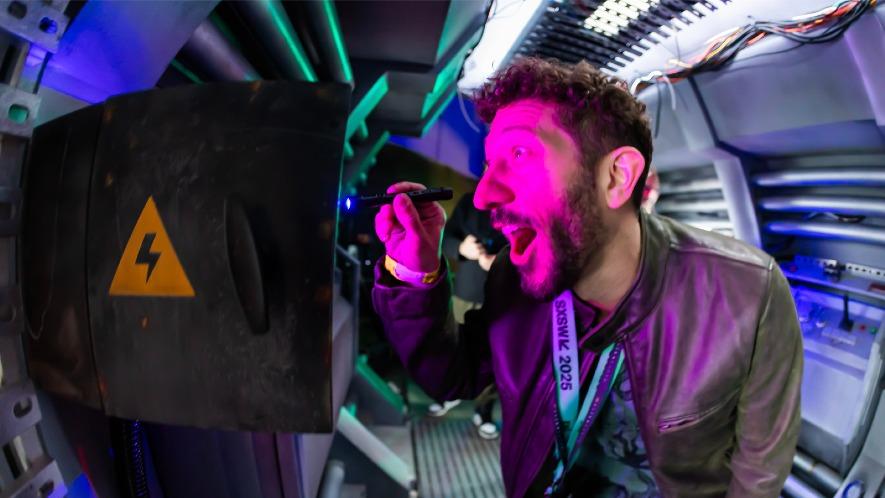A team of PwC industry specialists was on the ground at SXSW in Austin, attending 100+ sessions alongside visionaries, creators, scientists and leaders. Together with SXSW, we’ve captured the key learnings that matter most so you can harness human ingenuity to help shape what's next for your business, your industry and the world. This SXSW 2025 Key Insights report is your strategy playbook for the eight boldest shifts transforming business, technology and society –– today and tomorrow. Business and technology leaders should use these insights to think bigger, move faster and build smarter.
The eight revolutionary shifts explored at SXSW 2025:
From AI that amplifies human creativity to quantum breakthroughs, immersive brand worlds and healthcare innovations moving at lightspeed, continue reading to discover how technology will supercharge human ingenuity to build the future — and how your organization can be a part of it.
“AI fundamentally changes the nature of human capabilities, even what it is to be human.”
Neil Redding, Featured Session: The Auto-Evolving Business: AI’s Agentic Near Future1. Amplifying ingenuity: AI’s creative renaissance

AI isn’t just reshaping workflows; it is reshaping what we believe humans are capable of. At SXSW, a new perspective emerged: AI is not here to replace us, but to unlock new dimensions of creativity, problem-solving, and human connection.
AI is the tool—Human potential is the strategy
AI is no longer an edge case—it’s a defining force in how ideas are developed, decisions are made, and industries evolve. Leaders who wait for perfect clarity will find themselves outpaced by those who act now. The opportunity isn’t just to integrate AI—it’s to reshape what your organization can imagine, build, and become. This is a call to lead: reimagine workflows, empower every team with AI fluency, and invest in creativity and curiosity as core capabilities. The future will favor those who treat AI not as a threat to manage, but as a partner to help redefine what’s possible.
A closer look
What business leaders need to know
- Use AI as a creativity engine: Don’t limit AI to productivity gains. It can spark new industries, art forms, and breakthroughs. Well-designed AI needs human oversight and iterations to refine and guide AI’s outputs.
- Build AI-human hybrid teams: The value from AI often comes when human expertise and machine intelligence work together. Encouraging collaboration between people and AI systems improves design, product development, and operational decision-making.
- Rethink workflows: AI introduces new possibilities that often do not fit into existing processes. Leaders may want to evaluate where current workflows limit impact, and where redesigning around AI can enable speed, insight, and scalability.
- Encourage AI experimentation for all: AI isn’t just for the IT team, encourage broad AI adoption and use. Giving departments the space to explore and apply AI in their own contexts can spark innovation, improve adoption, and generate use cases that reflect real business needs.
- Embrace Unique + Tailored Data and AI Models: As general-purpose models become widely accessible, organizations that invest in models based on proprietary data and domain-specific knowledge can create more defensible value. As one speaker said, “LLMs will make you average – real value will come from proprietary knowledge and experience.”
- Invest in talent upskilling: AI adoption requires a workforce that is ready to use it with confidence and purpose. Organizations that prioritize clear communication, capability building, and practical training will be better positioned to scale impact and adapt over time.
- Responsible AI: As AI becomes a central driver of business strategy, leaders must adopt a responsible AI framework that balances innovation with ethical, regulatory, and societal considerations. With rising political and policy scrutiny around data governance and platform regulation, responsible AI is no longer just about compliance—it’s a strategic advantage in building trust and long-term competitiveness. For more on considerations in this space please refer to Insight #3.
“Quantum computing is no longer a distant future – it is already proving useful today. By 2026, it will surpass classical computing in solving problems that were previously impossible.”
Session: Cracking the ‘Cradle of Life’ Molecule with a Quantum Computer2. Take the quantum leap – Computing's next revolution is here

Quantum computing is set to revolutionize our world – from developing new drugs and materials, to helping bring back lost species. It has gone from something far in the future to something expected to drive meaningful innovation in the near term.
Quantum is out of the lab, and into the market
The message from the experts is clear: Quantum computing isn’t a 20-year from now idea— it’s happening now. Quantum computing is a really complicated subject, and it provides the ability to build upon and solve complex problems that are often too time consuming for even the most powerful traditional computers. Companies that invest early will shape the industries of the future, while those that hesitate will be left playing catch-up. The question isn’t whether quantum computing will change your industry—it’s whether you’ll be ready when it does.
A closer look
What business leaders need to know
- Develop a quantum strategy – Quantum computing is not a distant technology—it is already being tested in real-world applications. Businesses in industries such as logistics, finance, and telecommunications should start exploring cloud-based quantum services, conducting proof-of-concept studies, and developing internal expertise to prepare your organization to understand and think about how quantum will impact your business and industry.
- Invest in talent and partnerships – The biggest bottleneck in quantum adoption isn’t hardware—it’s expertise. Organizations should start building quantum talent pipelines and forming strategic partnerships with leading quantum research labs, cloud providers, and startups.
- Identify industry-specific quantum use cases – Business leaders should conduct internal assessments to identify where quantum computing could provide an immediate advantage—whether it’s optimization, material design, risk modeling, or beyond.
- Stay ahead of policy and security risks – Quantum computing will eventually break today’s encryption standards. Governments and corporations need to invest in post-quantum cryptography now to protect sensitive data.
“Uncertainty raises risk and slows investment. [Strong economic] policy needs clear, transparent and stable regulatory models.”
Session: Innovations Driving the Future of Energy3. Companies that master policy shifts will shape the future

The intersection of policy, economics, and innovation has grown increasingly complex and dynamic. At SXSW, the message was clear: regulation will evolve, markets will shift, and industries will be disrupted—but those who move decisively, invest strategically, and shape their own path forward will define what comes next.
Geopolitics is the new innovation battleground
Innovation doesn’t happen in isolation—it’s shaped by policy, investment, and economic forces. Public and private partnerships working together to accelerate innovation and help keep markets that invest in the cutting edge. The companies and industries that act now— investing in talent, technology, and trust—will be the ones defining the future.
A closer look
What business leaders need to know
- Track and anticipate policy changes. AI regulations, energy policies, and trade shifts will directly impact business models. Leaders must stay ahead of these changes to identify business shifts in a timely manner. Organizations also have a role in helping policy makers understand the benefits of investing in long term innovation, and the risks associated with tariffs and trade uncertainties.
- Invest in public and private collaboration models for innovation. Examples include partnerships with state agencies and universities to foster quantum campuses to bring together researchers to unlock innovation.
- Adapt digital brand and marketing strategies for an evolving regulatory landscape. With platform restrictions and data privacy laws shifting, companies should invest in first-party data, diversify content strategies, and build resilience into their digital marketing plans.
- Invest in technology and innovation early. Businesses that embrace AI, quantum computing, and sustainable solutions now will lead their industries as regulations and market dynamics evolve. Understand consumer and business sentiments and build trust in responsible innovation to drive adoption.
- Prepare the workforce for the future. Addressing the talent gap in AI and emerging tech will require collaboration with policy makers and educational institutions, in addition to corporate investment in education, training, and upskilling programs.
“Your kid in their bedroom [online] might be encountering more danger than they would out at the park with friends.”
Lauren Greenfield, Session: Gen Z Social Media’s Dark Side - Brand and Advertising4. Digital safety is about minds, not machines

As more of our lives are digital, it drives increased risk that digital experiences have an outsized influence on human behavior in both positive and detrimental ways. With humankind already spending considerable time online, and AI and other innovations poised to create even more compelling digital experiences, the imperative for ethical and thoughtful innovation has never been higher.
Protecting minds, not just machines
As technology becomes more immersive, intelligent, and embedded in daily life, the real risk isn’t just what systems can do—but how they shape what we think, feel, and choose. Protecting users now means protecting attention, autonomy, and agency. Business leaders must prioritize ethical design, transparent AI, and proactive trust-building to make sure innovation advances not just technology—but humanity.
A closer look
What business leaders need to know
- Audit for influence, not just security – Businesses must analyze not just how secure their systems are, but how their digital experiences subtly shape behavior, decisions, and perceptions over time.
- Build ‘Ethical Friction’ into digital experiences – Create intentional design breaks that force users to pause before making high-stakes decisions, whether in finance, media, or e-commerce.
- Develop AI that explains itself – Black-box AI models won’t cut it. Leaders must push for systems that show their reasoning and give users control over how they engage with recommendations.
- Defend cognitive bandwidth as a security asset – Protecting attention spans and decision-making ability should be treated as a core security issue, just like data encryption.
- Anticipate the trust crisis – Organizations need preemptive strategies for when deepfake fraud, AI persuasion, or behavioral engineering scandals inevitably shake consumer confidence.
- Develop strong AI governance models and advocate for thoughtful policies and regulation that foster digitally safe, inclusive, private experiences for consumers online.
“The things that stand out, the things that are remembered, are always different.”
Melina Palmer, Session: Enough with the “Delving” – Staying Human in the Age of AI5. The power of experiential brands

The most memorable brands aren’t built through messaging alone—they’re built through moments and stories that people can feel, remember, and share.
From reach to relationship
The future belongs to brands that don’t just speak—but invite participation. In a world where audiences expect to be part of the story, the most powerful connections are built through shared experiences, creator collaboration, and storytelling that adapts in real time.
Emerging technologies (like AI and XR) can extend that creative canvas—but it’s imagination, trust, and emotional relevance that drive true impact. The brands that lead tomorrow will be the ones that engage meaningfully today.
A closer look
What business leaders need to know
- Prioritize deeper engagement over exposure. Customers don’t just want to be reached—they want to feel connected. For consumer brands, this could mean immersive experiences or AI-powered personalization. In industries like retail or fitness, it might be thoughtful content, expert-led discussions, or tools that provide real value. The key is making interactions meaningful.
- Think beyond platforms—build ecosystems. Content, commerce, and community now overlap. For some industries, this means seamless omnichannel marketing; for others, it’s integrating expertise and education into their brand presence. The goal is a consistent, valuable experience across touchpoints.
- Balance analytics with emotional intelligence. Data should inform, not dictate. Use predictive insights to guide decisions, but lean into storytelling, creative risks, and human connection to build long-term trust and engagement.
- Rethink partnerships for deeper impact. The creator economy has evolved—collaborate with creators, experts, or thought leaders as strategic partners, not just spokespeople. Whether through co-branded content, industry collaborations, or ambassador programs, partnerships should drive lasting value, not just visibility.
- Use AI to enhance, not replace creativity. AI should support human originality, not automate sameness. Use it to analyze trends, streamline workflows, and personalize messaging, but let human insight, emotion, and authenticity drive storytelling and customer interactions.
- Reimagine the way creative teams work together. The traditional structure of design teams is evolving, shifting from large, specialized groups to small, agile, and AI-augmented teams that prioritize speed and value-driven innovation. Designers should think more like product managers, making sure their work is directly tied to business outcomes rather than just aesthetics. The emergence of industry-leading GenAI tools and low-code/ no-code platforms allows designers to move beyond execution into rapid prototyping and iterative experimentation. Rather than fearing AI, design teams should integrate AI tools into their workflows, using them to automate repetitive tasks, generate insights, and accelerate creative problem-solving while maintaining human-centered design principles. Marketers and planners also have the ability to embrace AI in their work, using it as a creative partner in planning and a tool to reduce administrative / lower value tasks.
“We are not just treating disease—we are reprogramming the human body at the genetic level. This is a tidal wave of innovation, and it’s coming faster than you think.”
Nicole Paulk, Session: Viruses as Medicine: Shaping the Frontier of Gene Therapy6. AI isn’t replacing doctors – It's accelerating cures

Healthcare is undergoing a transformative era of rapid innovation and breakthroughs, yet progress remains challenged by deep-rooted systemic inequalities and complex ethical considerations.
This year’s SXSW sessions showcased groundbreaking advancements in brain science, precision medicine, and AI-driven diagnostics, ushering in a new treatment era for conditions once considered untreatable—those previously thought impossible to treat with medication. Rapid progress in neurodegenerative disease and cancer research is being fueled by AI and stem cell-derived organoids. The benefits from this innovation will extend beyond healthcare—Alzheimer’s alone is projected to cost the U.S. $1 trillion annually by 2050, posing major implications for the workforce and caregivers1. The development of curative treatments in these areas will have a profound impact on all Americans.
The business of health is everyone’s business
AI and emerging technologies are revolutionizing drug discovery, diagnostics, clinical trials, and health data management. Business leaders have a key role in building a more effective and equitable healthcare system. With Americans spending $500 billion annually out-of- pocket on healthcare, Healthcare Consumerism is gaining momentum, shifting power back to patients and caregivers. To thrive in this evolving landscape, companies must drive meaningful change by improving accessibility, enhancing the consumer experience, and expanding direct-to-patient care models.
A closer look
“Going to space is hard, but collaboration makes it possible—no one company or agency can do it alone, and that’s what makes this new era of exploration so exciting.”
Trina Patterson, Session: Messaging the Moon7. Space is open for business

Space’s role is going well beyond exploration—it is rapidly becoming a proving ground for groundbreaking innovation across industries. From using microgravity to advance health research (such as aging studies and dementia treatments) to building the infrastructure for off-Earth living, space is playing a crucial role in shaping the future. With AI-enabled discovery, commercial investment, and new partnerships between public and private sectors, the industry is expanding. NASA continues to play a leading role, but new opportunities are emerging for private companies, entrepreneurs, and cross-sector innovators to actively contribute to and benefit from this growing ecosystem, offering strategic advantages for industries beyond aerospace.
Space is no longer a mission—it’s a market
The acceleration of AI-powered research, private-sector collaboration, and affordable space access is shifting space from a government-funded mission to a commercial frontier. Companies that integrate space-driven insights, technology, and partnerships into their strategies today will shape the next era of innovation, sustainability, and economic growth. Space is no longer just for astronauts—it’s a business opportunity with limitless potential.
A closer look
What business leaders need to know
- Recognize space as a strategic investment, not just science – Companies across industries should explore R&D opportunities in space-driven technology, leveraging insights from microgravity, AI, and resource extraction.
- Embrace public-private collaboration – Businesses should form strategic partnerships with government agencies, aerospace firms, and space-tech startups to integrate space-driven advancements into their industries.
- Prepare for the next industrial revolution – Off-Earth economies will become a reality in the next decade. Companies that invest early in space logistics, sustainable energy, and advanced materials will have a first-mover advantage.
“If we embrace technology, we have the opportunity to completely reshape not just our physical space, but also now, the cognitive one.”
Ian Beacraft, Session: How Not to Screw up an AI Transformation8. Immersive tech is redefining fandom

Artists are unlocking more immersive fan experiences that unlock a new layer of authentic creation and access. These experiences are paving the way for creator and tech partnerships—and the future of fandom in VR and other environments. Fans are also being invited more and more to co-create content and shape the future of entertainment.
Fandom is a platform, not just a market
The future of entertainment belongs to those who design with their audiences. As fans become collaborators, co-creators, and stakeholders, the companies that thrive will be the ones that build living, participatory ecosystems—where content evolves, engagement is active, and value is shared. Passive consumption is out; immersive, co-created experiences are in. This shift isn’t just transforming how we entertain—it’s redefining how creators, brands, and platforms operate. At SXSW, that momentum was palpable. From hallways to headline sessions, creators stood alongside technologists, marketers, and storytellers, not on the sidelines, but in the mix, helping shape what’s next. For anyone looking to understand or participate in the future of media, community, and commerce, SXSW offers more than access. It offers a blueprint.
A closer look
What business leaders need to know
- Stop thinking in terms of “Audience Engagement”—think in terms of “Experience Architecture” – The best entertainment is no longer made for fans, but with them.
- Invest in participation-driven revenue streams – AI-assisted content creation, interactive live shows, and co-owned digital assets will outperform traditional ad models.
- Create spaces, not just content – The future of fandom isn’t static—it’s immersive. Companies must invest in digital, physical, and hybrid experiences that evolve over time.
- Look to gaming and interactive media for inspiration – The entertainment world is following gaming’s lead. Those who embrace co-created, interactive experiences will define the next cultural frontier.
- Recognize creators as cultural architects – The Creator Economy is more than new monetization models, it’s about modes of influence. At SXSW, creators showed how they are shaping storytelling, product development, fandom, and even labor norms. Business leaders should pay attention, not only to partner, but to learn.
1Alzheimer’s Association. 2024 Alzheimer’s Disease Facts and Figures. Alzheimer’s Association, 2024, https://www.alz.org/getmedia/76e51bb6-c003-4d84-8019-e0779d8c4e8d/alzheimers-facts-and-figures.pdf.
2GoodRx Research. The Prescription Drug Gender Divide: Women Spent Over $8.5 Billion More Than Men in 2024. GoodRx, 7 Mar. 2025, https://www.goodrx.com/healthcare-access/research/prescription-drug-gender-gap-women-spend-more
SXSW 2025 insights report
What business and tech leaders should know for the year ahead
Contact us











